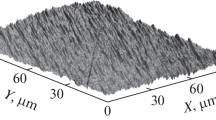Abstract
The alumina scales on a variety of high-temperature alloys are found to fluoresce when illuminated with light having a frequency greater than 18,000 cm−1. The fluorescence exhibits two narrow lines characteristic of chromium-doped alpha-aluminum oxide. The frequency shift of the two lines from the room-temperature, stress-free values of 14,402 cm−1 (1.786 eV) and 14432 cm−1 (1.789 eV) provides a noncontact measure of the stress in the alumina scales using the piezospectroscopic effect. In addition, the broadening of the lines is a measure of the stress gradient in the scale. The physical basis for the fluorescence technique is described together with its implementation for highspatial-resolution (∼2 μm) measurements. As illustration, room-temperature measurements of the residual stress in scales formed at 1100°C on single-crystal NiAl, polycrystalline Ni3Al, two Fe−Ni−Cr−Al alloys, and two Ni−Al base superalloys are presented.
Similar content being viewed by others
References
A. M. Huntz, inThe Role of Active Elements in the Oxidation Behaviour of High Temperature Metals and Alloys, E. Lang, ed. (Elsevier Applied Science, New York, 1989).
P. D. Dankov and P. V. Churaev,Dokl. Akad. Nauk. SSSR 73, 1221 (1950).
F. N. Rhines and S. J. Wolf,Metall. Trans. 1, 1701 (1970).
H. Engell and F. Wever,Acta Metall. 5, 695 (1957).
J. Birnie, C. Craggs, D. J. Gardiner, and P. R. Graves,Corros. Sci. 33, 1 (1992).
A. L. Schawlow, inAdvances in Quantum Electronics, J. R. Singer, ed. (Columbia Press, New York, 1961).
L. Grabner,J. Appl. Phys. 49, 580 (1978).
Q. Ma and D. R. Clarke,J. Am. Ceram. Soc. 76, 1433 (1993).
J. He and D. R. Clarke,J. Am. Ceram. Soc. 78, 1347 (1995).
A. A. Kaplyanskii, A. K. Przhevuskii, and R. B. Rozenbaum,Sov. Phys. Solid State 10, 1864 (1969).
J. He and D. R. Clarke, unpublished.
A. G. Evans and D. R. Clarke, inThermal Stresses in Materials and Structures, D. P. H. Hasselman and R. A. Heller, eds. (Plenum Press, New York, 1980).
J. E. Blendell and R. L. Coble,J. Am. Ceram. Soc. 65, 174 (1982).
Q. Ma and D. R. Clarke,J. Am. Ceram. Soc. 77, 298 (1994).
D. M. Lipkin and D. R. Clarke,J. Appl. Phys. 77, 1855 (1995).
J. D. Kuenzly and D. L. Douglas,Oxid. Met. 8, 139 (1974).
R. Christensen, D. M. Lipkin, and D. R. Clarke, to be submitted.
D. M. Lipkin, D. R. Clarke, M. Hollatz, M. Bobeth, and W. Pompe,Corrosion Science, in press.
R. L. Farrow, P. L. Mattern, and A. S. Nagelberg,Appl. Phys. Lett. 36, 212 (1980).
Author information
Authors and Affiliations
Rights and permissions
About this article
Cite this article
Lipkin, D.M., Clarke, D.R. Measurement of the stress in oxide scales formed by oxidation of alumina-forming alloys. Oxid Met 45, 267–280 (1996). https://doi.org/10.1007/BF01046985
Received:
Revised:
Issue Date:
DOI: https://doi.org/10.1007/BF01046985




